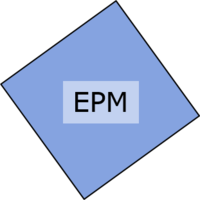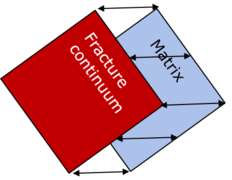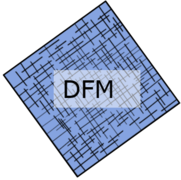Model output
| Highlights |
|---|
|
ContentsDiscussion of model conceptsEquivalent porous medium (EPM) modelThe EPM model is the simplest of the considered models and is widely used in practice. Compared to the dual-continuum model or the discrete-fracture model, it has low computational costs. It is well-established for porous media systems without fractures. However, for fractured aquifers, it should only be used for a rough approximation and with care, particularly for solute transport. It cannot reproduce the interactions between fractures and matrix (diffusive mass exchange, storage in matrix). Particularly for long-term simulations, where matrix diffusion usually plays an important role, an EPM model will lead to incorrect results. That the EPM model fails in fractured limestone aquifers becomes obvious when trying to simulate the tracer tests, which were performed at the Akacievej site. A homogeneous EPM model could only reproduce the fast arrival observed in the tracer tests by lowering the (effective) porosity to very low values (below 1 %, in the order of the fracture porosity). Then, however, the simulated peak concentrations were higher than the observed ones, because diffusive exchange of tracer with the matrix is neglected by the model. Hence, the simulated tracer breakthrough concentration decreased early, and the tailing observed in the field tests could not be reproduced. An application of the EPM model calibrated to one tracer test to another one with different flow conditions or at a different location lead to poor results and required a recalibration of the model. It is possible to obtain a tailing in the simulated breakthrough curve if a heterogeneous parameter distribution in the porous medium is included (Figure 6.9), introducing very conductive structures and less conductive structures that are less penetrated by flow [1]. However, the variation of the hydraulic conductivity has to be of a similar order of magnitude as the contrast between fracture and matrix conductivity and it has to have a similar connectivity of the highly conductive zones (fractures). Note that a different vertical placement of the screens for injection and extraction can also lead to a tailing in the breakthrough curves. The use of an EPM model for the simulation of the fate of a contaminant in a fractured limestone aquifer is not recommended, because exchange processes between fractures and matrix are generally neglected and model results may be misleading for risk assessment or remedial planning.
For example, remediation times can be greatly underestimated because the effect of back-diffusion from the matrix cannot be reproduced.
It is preferable to include fractures in a model as discrete features in order to better reproduce the actual physics.
Dual-continuum model (DCM)The dual-continuum model matches the observed tracer breakthrough curves from the Akacievej tracer tests better than the EPM model.
The fractures and the matrix are each represented as a continuum and the coupling of the two continua allows for an exchange of substances between fractures and matrix.
With a DCM, the breakthrough behavior can be reproduced by choosing appropriate fracture and matrix porosities and conductivities, and by fitting the parameters controlling the exchange between fractures and matrix (Dpm, α, a).
However, this concept has many degrees of freedom, and it is not clear how to determine the required parameters governing the fracture-matrix exchange experimentally.
The DFM is also reported in the literature to be a “black-box” model [2].
The computational effort required to run this model type is usually moderate.
It has been reported in the literature that the dual-continuum model has to be recalibrated, when it is used with different flow conditions or at different scales.
Discrete-fracture model (DFM)The discrete-fracture model aims at representing the actual physics in a fractured limestone aquifer and yields the best results. Drawbacks are the often limited knowledge of the fracture parameters and geometry, the complexity of the model and the high computational costs. The inclusion of fractures requires a very high grid resolution next to them to correctly resolve concentration gradients, and the computational effort usually limits the number of fractures that can be included in a model. When setting up the model for the tracer tests at the Akacievej site, it was sufficient to include major horizontal fractures to provide preferential flow paths for the tracer transport to obtain a fast tracer arrival and the tailing caused by the matrix diffusion. However, this has to be based on the observed fracture pattern. The horizontal fractures were placed at locations where high-flow zones were seen on flow logs in the boreholes (indicating horizontal fractures), see Chapter Data acquisition for more information. However, at the Akacievej site, the limestone is likely to have many more fractures at different scales, providing a bigger specific surface area for the exchange between fractures and matrix and leading to more matrix diffusion. The neglected fractures can be accounted for by adjusting the effective matrix diffusion coefficient, which also controls the exchange fluxes between fractures and matrix. Since the major horizontal fractures were resolved in the model and neglected fractures were mostly subvertical and vertical ones, only the vertical components of the effective diffusion coefficient were increased. This is described further in the following report (in Danish): Moreover, increasing the effective diffusion coefficient can also help to account for stagnant flow zones, small-scale turbulences and channeling within fractures with varying aperture [2] [3].
However, the increased effective diffusion coefficient may have to be adjusted when a different spatial or temporal scale is simulated.
In the simulations of the tracer tests at the Akacievej site, the effective diffusion coefficient had to be increased by a factor of 100 to 1000 in order to fit the observed breakthrough behavior.
ComparisonThe tracer tests and model applications have clearly shown that a crucial aspect of the transport of a substance in fractured limestone cannot be reproduced with a simple equivalent porous medium model: the diffusion and back-diffusion of a substance between fractures with strong flow and low-conductive matrix. In a fractured aquifer, this should be accounted for, or the propagation of a substance will not be realistically simulated. Hence, the use of a traditional equivalent porous medium model is not recommended for fractured limestone aquifers. The dual-continuum model can describe the exchange between fractures and matrix while keeping computational efforts low. However, the specification of the exchange terms between fracture and matrix continuum has a crucial influence on the modeling results and a physically-based choice is often challenging. It is not clear how to determine the exchange parameters by measurements. Further, it is questionable if a model, once calibrated, can be employed at a different scale without modifying the used parameters. A requirement for the use of a dual-continuum model is a fracture network with many connected fractures with a relatively uniform distribution, since the fractures are represented as averaged quantities in the fracture continuum. The use of a discrete-fracture model comes with the cost of being the most complex and numerically demanding model described here. However, it represents the actual physics best and can, depending on the knowledge of the fracture system, yields the best results. Usually, only few details about the fracture network are available, which restricts the setup of a detailed model. In this study, the information provided by flow logs could successfully be used to setup a representative network containing the major horizontal flow paths. But such a model does not contain smaller fractures and to compensate for that the diffusion coefficient governing the exchange between fractures and matrix had to be greatly increased. With that, the measured breakthrough curves from the tracer tests could be reproduced. The tracer test in Geo18s before pumping clearly shows that the discrete-fracture model best reproduced the observed data. Since matrix and fractures are both included in the model and the exchange between the two happens naturally (continuity of fluxes, concentrations and heads at the fracture-matrix interface), the discrete-fracture model is the recommended approach in cases where fractures dominate the transport behavior and matrix diffusion occur. Even a simple analytical tool (such as Chambon et al. 2011 [4]) or a dual-continuum model should be preferred to an equivalent porous medium model, which completely neglects the influence of the fractures. Recommendations for modeling flow and transport in fractured limestone aquifers
|
- ↑ Pedretti et al. (2013), On the formation of breakthrough curves tailing during convergent flow tracer tests in three-dimensional heterogeneous aquifers, Water Resources Research, 49, 4157-4173.
- ↑ 2.0 2.1 Riley et al. (2001), Converging flow tracer tests in fissured limestone, Quarterly Journal of Engineering Geology and Hydrogeology, 34, 283-297.
- ↑ DeDreuzy et al.(2013), Multi-Rate Mass Transfer (MRMT) models for general diffusive porosity structures, Advances in Water Resources, 76, 146-156.
- ↑ 4.0 4.1 Chambon et al. (2011), A risk assessment tool for contaminated sites in low-permeability fractured media, Journal of Contaminant Hydrology, 124, 82-98.




